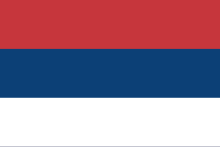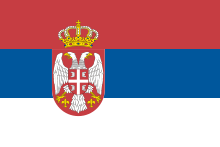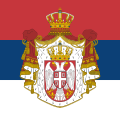Flag of Serbia: Difference between revisions
Curb Chain (talk | contribs) →External links: removed unncessary space |
|||
| Line 148: | Line 148: | ||
*[http://www.zastave-grbovi.com/?jez=en&menu=1 Flags and arms of Serbia] |
*[http://www.zastave-grbovi.com/?jez=en&menu=1 Flags and arms of Serbia] |
||
{{-}} |
|||
{{Flag of Europe}} |
{{Flag of Europe}} |
||
{{National symbols of Serbia}} |
{{National symbols of Serbia}} |
||
Revision as of 06:04, 17 August 2011
 | |
| Use | National flag and state ensign |
|---|---|
| Proportion | 2:3 |
| Adopted | June 2004, redesigned November 2010 |
| Design | Horizontal tricolour of red, blue and white, charged with lesser coat of arms. |
 | |
| Use | Civil flag and ensign |
| Proportion | 2:3 |
| Adopted | June 2004 |
| Design | Horizontal tricolour of red, blue and white |
The flag of Serbia is a tricolour consisting of three equal horizontal bands, red on the top, blue in the middle and white on the bottom. The same tricolour, in some variations, was the flag of Serbia throughout its history, and is the ethnic flag of the Serbian people. The state flag bears the lesser coat of arms, centered vertically and shifted to the hoist side by one-seventh of the flag's length.[1]
The current form of the flag was officially adopted in November 2010.[2]
Design
The flag ratio is 2:3 (height/width), with the three colours each taking one third of the height. Recommended colours are:[3]
| System | Red | Red | Blue | Yellow | Black |
|---|---|---|---|---|---|
| Pantone | 192C | 704C | 280C | 123C | X |
| CMYK | 0-90-70-10 | 0-90-70-30 | 100-72-0-19 | 4-24-95-0 | X-X-X-100 |
Other official flags of Serbia
-
Standard of the President of Serbia
-
Standard of the President of the National Assembly of Serbia
-
Flag of the River Flotilla of the Serbian Armed Forces
History
Flag of Stefan Vladislav


 Flag of Vladislav I as described 1281 (r. 1233-1243)
Flag of Vladislav I as described 1281 (r. 1233-1243)The oldest known description of a flag of Serbia is from the 1281 description of a flag in the treasury of Stephen Vladislav I of Serbia (1233–1243), which was kept in the Republic of Ragusa. The description lists "vexillum unum de zendato rubeo et blavo" - a flag of fabric red and blue (zendato - čenda a type of light, silky fabric).[4] A flag design usually seen in commemorations of medieval events have this horizontal diband.[5] As Vladislav ruled from 1233 to 1243 and died after 1264, the flag predates the time of the description, and as it was found in royal treasury it's possible to have been used even earlier.
Flag of Tsar Dušan


 Flag of Dušan the Mighty (1339)
Flag of Dušan the Mighty (1339)The oldest known drawing of the flag is from a 1339 map made by Angelino Dulcert. The map depicts a number of flags, and Serbia is represented by a flag placed above Skoplje (Skopi) with the name Serbia (Seruja) near the hoist, which was characteristic for capital cities at the time of the drawing of the map. The flag represented the realm of Stephen Uroš IV Dušan of Serbia, who in 1345 became Emperor of Serbs and Greeks when he founded the Serbian Empire. The flag is red double-headed eagle on a yellow field.[6]
Revolutionary flags


 A flag from the First Serbian Uprising.
A flag from the First Serbian Uprising.During the First Serbian Uprising, a large variety of flags was used. Among the early flags, the one described by Mateja Nenadović could be connected with today's flag: it was white-red-blue with three crosses.[7] Regular armies of the uprising usually had light yellow flags with various symbols, while voivode flags were often red-white, and defaced with black two-headed eagle. There were also flags of other colors, including red-yellow, red-white-blue and red-blue. This variety of colors was followed by variety of symbols on the flags, most often taken from Hristofor Zhefarovich's stematography. The most common symbol on the flags were the Serbian cross, followed by coat of arms of Tribalia and various other crosses.[8] Most of the flags were made in Sremski Karlovci, designed by Serbian painters Stefan Gavrilović, Ilija Gavrilović and Nikola Apostolović.[8]
Modern flags

The 1835 Sretenje Constitution described the colors of Serbia as bright red, white and dark blue (čelikasto-ugasita)[9]. The constitution was criticized, especially by Russia, and the flag was specifically singled out as being similar to the revolutionary flag of France.[10] Soon afterwards, Miloš Obrenović was requesting to the Porte that the new constitution should contain an article about the flag and coat of arms,[11] and subsequent ferman (1835) allowed Serbs to use their own maritime flag, which will have "upper part of red, middle of blue, and lower of white",[12] which is the first appearance of the colors which has remained until today.[13]
The colours are the reverse of those on the flag of Russia, and various popular stories exist in Serbia which seek to explain why. An example:[14]
In Karađorđe's time, a delegation from Serbia went to Russia to seek help, and after arrival was at a celebration. When they were asked why don't they participate in the parade, they hastily entered and turned the Russian flag upside down. The citizens have thus noticed that Serbs have their flag too.

 Socialist Republic of Serbia (1945–1992)
Socialist Republic of Serbia (1945–1992)Serbia used the red, blue and white tri-colour continuously from 1835 until 1918 when Serbia joined Kingdom of Yugoslavia. After World War II, Yugoslavia was reformed into a socialist federal republic, composed of six republics, one of which was Serbia. Each republic was entitled to its own flag on the condition that it contain the socialist red star.[15]


Following the breakup of Yugoslavia, Serbia initially continued using the same flag; the 1990 Constitution of Serbia stated that flag and coat of arms of Serbia can only be changed by the same procedure used to change the constitution itself.[16] The red star was removed from the flag in 1992[15][17] (however, the coat of arms remained the same). In 2003 however, the government of Serbia issued a recommendation on flag use, that recommended using different flag and coat of arms from the ones in the constitution.
The 2006 Constitution of Serbia stated that the state emblems will be regulated by law;[18] the recommendation remained in use until May 11, 2009, when actual flag law was enacted.[19] In November 11, 2010, a graphical redesign of the Coat of arms was enacted, which is currently used on the state flag.[2]
Variants
The red-blue-white flag of Serbia was the basis for flags of other Serbian lands. Since 19th century, Montenegro used the same flag as its civil flag and as the basis for its naval flag.
During the second Yugoslavia, Serbia and Montenegro had one and the same flag. This continued in the Federal Republic of Yugoslavia, though in 1993 Montenegro changed the design slightly and in 2004 dropped use of the flag. The flag was also the basis for flags of the war-time Serbian Autonomous Oblasts, the Republic of Serbian Krajina, and the Republic of Srpska. After the FRY was reformed into Serbia and Montenegro, several designs were proposed for the flag of Serbia and Montenegro based on the flag of Serbia, but none of them were implemented.
The Flag of Serbia defaced with a Serbian cross is used as the flag of the Serbian Orthodox Church. A number of other variants, with the Serbian cross and modified Serbian coat of arms or other organizational coat of arms are in use by organizations or individuals.
Proper flag protocol
State flag
The state flag has small Coat of Arms of Serbia centered vertically and shifted to the hoist side by one-seventh of the length of the flag.[1] The state flag of Serbia is constantly flown on the entrance of a building of a state organ of Serbia, and displayed in their rooms. The military can display the state flag in the form of patch (subdued version) on their uniform. The National Assembly flies it only when in session and during state holidays. Organs of provinces, Vojvodina and Kosovo and Metohija, fly it only on state holidays.[20]
It can also be flown during celebrations and other solemn manifestations which mark events of importance for Serbia, and on other occasions.[21] During state mourning, it is flown at half mast but only by provincial and local organs and public services.[22]
The flag also has to be displayed in an election room during an election for state bodies[23] and in the room of civil registry dedicated for marriage (the registrar has to carry a sash with flag colors as well).[24]
Civil flag
The civil flag of Serbia is constantly flown on the entrance of the National Assembly and organs of provinces and public services. It must be displayed in an election room during an election for provincial or local organs.[25]
Also, it can be hoisted during celebrations and other cultural or sport manifestations, and on other occasions.[26]
Other flags
The President of Serbia and the Speaker of the National Assembly of Serbia use their respective standards instead of the national flag.[27]
Respect for the flag
Neither the state flag nor the civil flag can be hoisted so that they touch the ground, nor be used as rests, tablecloths, carpets or curtains, nor to cover vehicles or other objects, nor to attire speaker platforms or tables, except as table flags. They must not be used if damaged or otherwise look unsuitable for use.[28]
The flag is not flown in bad weather conditions. Also, it is flown only in daylight, unless it's illuminated.[29]
If the flag is flown vertically on tables or otherwise, its top field is on the left side of the viewer. If it is flown vertically across a street or square, its top field should be on the northern side if the street has east-west orientation, and eastern side if it has north-south orientation or on a circular square.[30]
Correct display
The law defines how the flag of Serbia is displayed along with other flags, making no difference between state flags and other kinds of flags.
If the flag is hoisted with another flag, it is always on the viewer's left, except during an official visit of a representative of another country or an international organization, when the flag of the visitor is it is on the viewer's left. If the flag is hoisted with another on crossed staffs, its staff must be the front one.
If the flag of Serbia is hoisted along with two flags, it must be in the middle.
If the flag is flown with multiple flags,
- If the flags are flown in a circle, it must be in the center of the circle, clearly visible;
- If the flags are flown in a semicircle, it must be in its vertex;
- If the flags are flown in a column, it must be in the front of the column;
- If the flags are flown in a row, it must be in the first place, that is, on the viewer's left;
- If the flags are flown in a group, it must be in the front of the group.[31]
See also
References
- ^ a b Препорука о коришћењу грба, заставе и химне Србије Template:Sr icon
- ^ a b Grb Srbije: Dvoglavi orao menja perje
- ^ Template:PDF Template:Sr icon
- ^ D. Samardžić. Vojne zastave Srba do 1918. Beograd: Vojni muzej, 1983
- ^ Flag of the Serbian Kingdom, XIIIth century at Flags of the World
- ^ Gordana Tomović. Monumenta Cartographica Jugoslaviae II, Beograd: Narodna Knjiga, 1979
- ^ B. A: Principality of Serbia (1830-1882) FOTW
- ^ a b Dragana Samardžić: Старе заставе у Војном Музеју, Belgrade 1993
- ^ "Глава друга. Боя и Грбъ Сербіє". Уставъ Княжества Сербіє (in Serbian (old orthography)). Kragujevac: Princedom of Serbia. 1835. COBISS.SR-ID 150291719. Retrieved 2011-06-18.
3.) Боя народна Србска єстъ отворено-црвена, бѣла и челикасто-угасита.
{{cite book}}: External link in|chapterurl=|chapterurl=ignored (|chapter-url=suggested) (help); Unknown parameter|trans_chapter=ignored (|trans-chapter=suggested) (help); Unknown parameter|trans_title=ignored (|trans-title=suggested) (help)CS1 maint: unrecognized language (link) - ^ Mih. Gavrilovic, Suspendovanje prvog srpskog ustava februar-mart 1835 god., Arhiv za pravne i drustvene nauke, I, 1906, 410-412
- ^ D. Samardzic, Vojne zastave Srba do 1918, Beograd, 1983
- ^ D. Matic, Javno pravo Knjazevstva Srbije, Beograd, 1851, 33
- ^ Volker Preuß. "National- und Staatsflagge des Königreichs Serbien". Retrieved 2004-11-03.
{{cite web}}: Cite has empty unknown parameter:|coauthors=(help) Template:De - ^ LJ. M. V. - J. Ž. S. (2006-08-01). "Hej, Bože pravde!". Vecernje novosti. Retrieved 2007-04-17.
- ^ a b Branislav Ž. Vešović: Yugoslavia during the Second World War
- ^ 1990 Constitution of Serbia, Article 5
- ^ Recommendation on the use of the Flag of Serbia ("Official Gazette of Serbia", No. 49/1992.)
- ^ 2006 Constitution of Serbia, Article 7
- ^ Закон о изгледу и употреби грба, заставе и химне Републике Србије, 2009-05-11
- ^ Conclusion on Use of the Coat of Arms, Flag and Anthem of Serbia, IV/1
- ^ Conclusion on Use of the Coat of Arms, Flag and Anthem of Serbia, IV/4
- ^ Conclusion on Use of the Coat of Arms, Flag and Anthem of Serbia, IV/3
- ^ Conclusion on Use of the Coat of Arms, Flag and Anthem of Serbia, IV/2
- ^ Family Law, article 299
- ^ Conclusion on Use of the Coat of Arms, Flag and Anthem of Serbia, IV/6
- ^ Conclusion on Use of the Coat of Arms, Flag and Anthem of Serbia, IV/7
- ^ Conclusion on Use of the Coat of Arms, Flag and Anthem of Serbia, IV/5
- ^ Conclusion on Use of the Coat of Arms, Flag and Anthem of Serbia, IV/8
- ^ Law on use of flag, anthem and coat of arms of the Federal Republic of Yugoslavia, Article 13
- ^ Law on the Use of the Flag, the Anthem and the Coat of arms of the Federal Republic of Yugoslavia, Article 12th
- ^ Law on use of flag, anthem and coat of arms of the Federal Republic of Yugoslavia, Article 11





